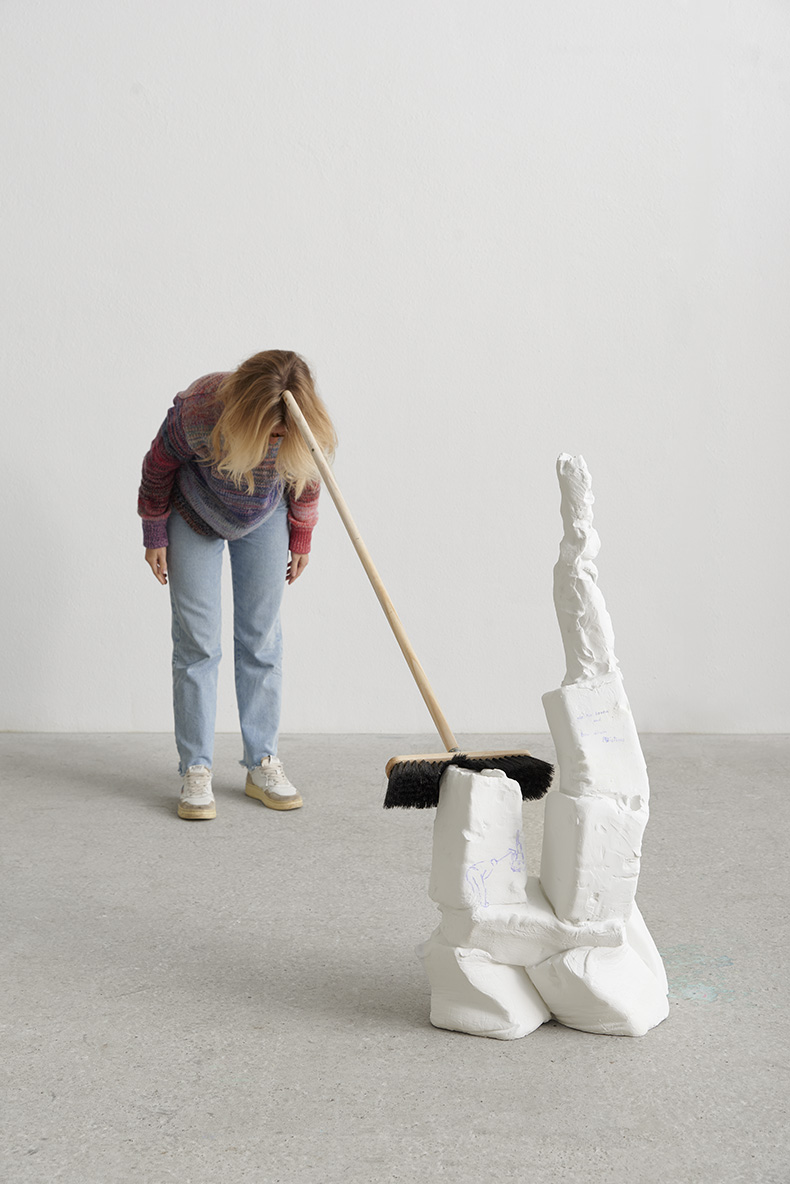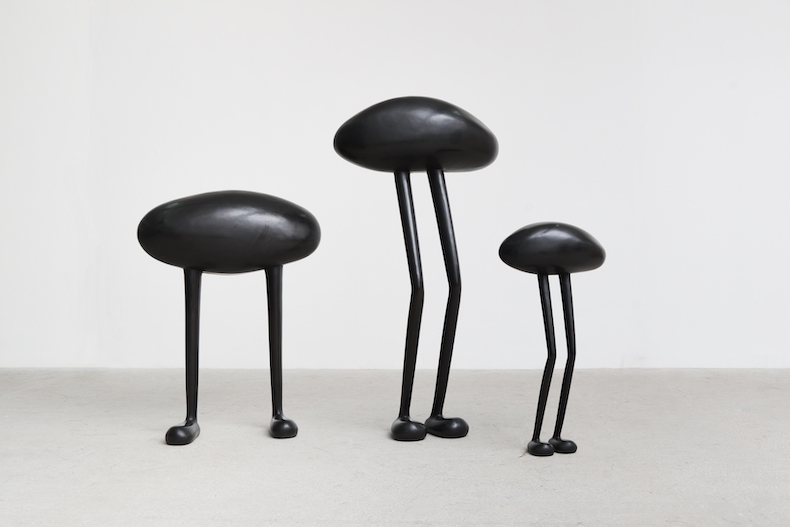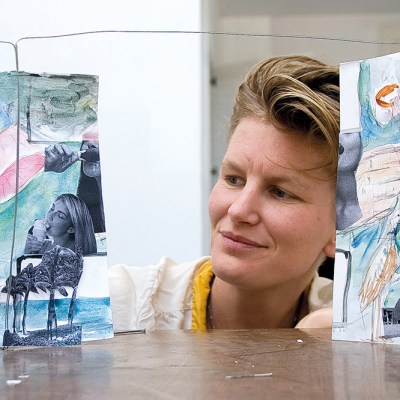Humour is one of the guiding principles behind the work of Erwin Wurm, the Austrian artist renowned for his playful, brightly coloured sculptures. Since the 1990s, Wurm has been engaged in an ongoing interactive series he calls One Minute Sculptures, in which artworks are made spontaneously and fleetingly by humans physically interacting with objects – lying on a pile of apples, for instance, or putting their head in a cabinet. More recently, Wurm has been producing sculptures with cartoonish human forms, such as oversized bodiless outfits and inanimate objects on human legs. His exhibition ‘Phantoms’ is currently on at König Galerie, Berlin, and runs until 22 June.
Where is your studio?
In Limberg, about an hour’s drive from Vienna. It’s in a big 12th-century house, with 12 different halls altogether. I wanted to have a studio in the countryside because it means I can have much more space than I could in the city, and I’m not disturbed by visitors passing by. I don’t even have my name on the door. People know that we’re there, and it’s nice when people visit, but not too often. I need it to be quiet so we can really concentrate on the work.
Obey (One Minute Sculptures) (2023), Erwin Wurm. Photo: Markus Gradwohl; courtesy the artist.

Who is your most frequent visitor?
Generally I prefer to be left alone so I can concentrate. It’s great that people come and have an interest in my work. That’s all fantastic. But it keeps you from working. So a good day for me is one without any visitors and one when I can make progress in my work. That’s fun for me.
How many people work in your studio?
We have 15 people. Some of my assistants have been working with me for more than 20 years. We have a carpenter, a painter, and an artist who works with plaster, and someone who works with spray paint and lacquer. And then we have five people in the office.
My son Michael is the studio manager. And my wife also works with us. She’s an assistant too: she makes the catalogue raisonné and runs my website. She’s really into research. She’s fantastic.
Installation view of Big Mutter (2015) by Erwin Wurm at Yorkshire Sculpture Park. Photo: © Jonty Wilde; © Erwin Wurm

Is it nice to be surrounded by your family at work?
Yes, sometimes. Not always.
Is there anything that frustrates you about your studio?
It frustrates me when the end of the day comes around, especially on a Friday. I would like to go on working. But of course, people need a rest and they need a weekend. I’m kind of a maniac: I’d like to go on and on.
Sculptures from the series Mind Bubbles (2023–24) by Erwin Wurm. Photo: Markus Gradwohl; © Erwin Wurm

Do you have a specific studio routine?
I’m married – to my second wife, but we’ve been together for 22 years – and we have a daughter who is 13. She needs to go to a good school and needs to have friends, so we have a flat in Vienna, where she lives and goes to school. It wouldn’t make much sense for her to spend all her time in the countryside. So I live in Vienna, but on a Sunday evening I go to the studio and stay there overnight. In the morning I have a session with my workout trainer – I have a fitness studio where I lift weights, because when you get older it’s very important that you lift weights, not only for the muscles, but also for the bones. I start work at 9am and then we have someone who cooks lunch for us. We eat and then we go on working and then it’s five, and bingo, it’s over. Then I drive back to Vienna and stay there overnight with my family and the next morning I come back to Limberg. So most weeks I’ll stay in the studio for three nights and have four nights in Vienna, including the weekend.
Installation view of ‘Phantoms’ at König Galerie, Berlin, in 2024. Photo: © Roman März; courtesy Erwin Wurm/König Galerie; © Erwin Wurm

Do you ever listen to music in your studio?
No. I live in a silent world. I drive a lot, so when I’m in the car I’ll often have music on or the news, but never in my studio. It would disturb me too much.
Do you talk to your assistants while you’re working?
Not really, except when we’re painting. I have a guy who helps me with painting – mixing the colours and preparing the canvases – and I like chatting to him while we’re doing that because it’s easy work and I don’t really have to concentrate. But when I’m concentrating on my art I want everything to be quiet, because I have lots of thoughts in my head and I don’t want to be disturbed. But it’s complicated when you have a family.
Installation view of ‘Phantoms’ at König Galerie, Berlin, in 2024. Photo: © Roman März/Erwin Wurm; courtesy Erwin Wurm/König Galerie; © Erwin Wurm

What is the most unusual object in your studio?
My studio is full of stuff. The object I like most is a huge sound bowl from Tibet, which is made from seven different materials: it has tiny bits of gold, silver, mercury, brass and other metals. It’s huge – almost 70cm in diameter – and is decorated with the most incredible patterns. And it makes a beautiful, enormous, fantastic sound – it’s almost physical, the sound of it. I use it several times during the day.
Erwin Wurm in 2024. © Erwin Wurm, Bildrecht, Wien, 2024

What is your most well-thumbed book?
I read a lot, although I find it more difficult nowadays because I have problems with my eyes. But I still read every day. I love Annie Ernaux. All her books are about her family, and it really reminds me of my relationship with my family. My father was a policeman and my mother was a housewife. They were lovely parents, but they weren’t interested in art at all. So when I turned 12 my father started giving me pocket money, which I would use to buy paperbacks and books about literature and philosophy. So I was opening a door into this different world, a world that my parents never had access to, and it was fantastic because it was my own world. And I didn’t want to let anybody else disturb me or intrude on this space. I think this is the reason that, when I began to exhibit, I didn’t like to invite my parents, because I had this feeling that they were somehow interfering. My wife was brought up very differently to me, because her parents were very supportive. She was able to share all her thoughts with her parents. And for me, this was impossible – sharing all that stuff with others was always a scary thought. Art gave me my own space and I didn’t want to let anybody else in. I see that feeling reflected in many of Annie Ernaux’s books.
Right now, I’m reading something that I always overlooked: Casanova’s life stories. They’re not just about sex. They’re so interesting, because they give a picture of the society he was growing up in. He was well educated and he travelled a lot, meeting all these grand and fantastic people, and he described it so well – it’s a great image of the past. I love Thomas Bernhardt too – mostly his theatrical pieces, because they’re essentially monologues. And because I’m about to turn 70, I’ve been reading Philip Roth. I like the way he describes getting old and impotent and all the problems that come with ageing. The way he writes about himself is so cynical – it’s fantastic. I love it.
As told to Michael Delgado
‘Erwin Wurm: Phantoms’ is at König Galerie, Berlin, until 22 June



